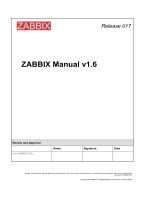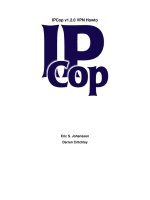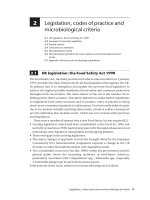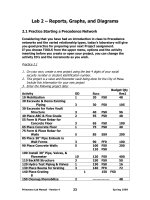FSPCA PC human food course participant manual v1 2 watermark
Bạn đang xem bản rút gọn của tài liệu. Xem và tải ngay bản đầy đủ của tài liệu tại đây (20.82 MB, 526 trang )
Preventive Controls
for Human Food
First Edition - 2016
Participant Manual
FOOD SAFETY PREVENTIVE CONTROLS ALLIANCE
Steering Committee (October 2015)
rs
i
on
JianghongMeng,JointInstituteforFoodSafetyand
AppliedNutrition–UniversityofMaryland,College
Park,MD
DianneMilazzo,U.S.FDA,CenterforVeterinary
Medicine,Rockville,MD
RamkishanRao,U.S.DepartmentofAgriculture,
NationalInstituteofFoodandAgriculture,
Washington,DC
DonaldSchaffner,RutgersUniversity,NewBrunswick,
NJ
JennyScott,U.S.FDA,CollegePark,MD
GuyE.Skinner,IFSH‐FDA,Chicago,IL
KatherineM.J.Swanson,KMJSwansonFoodSafety,Inc.,
MendotaHeights,MN(CurriculumDevelopment
Project Manager)
PatTovey,PetFoodInstitute,Washington,DC
W.HenryTurlington,AmericanFeedIndustry
Association,Arlington,VA
PurnenduC.Vasavada,PCV&AssociatesLLC,River
Falls,WI(Outreach Project Manager)
RobertD.Waltz,AssociationofAmericanFeedControl
Officials(AAFCO),WestLafayette,IN
JasonWan,IFSH‐IIT,Chicago,IL
GeraldWojtala,InternationalFoodProtectionTraining
Institute(IFPTI),BattleCreek,MI
Ve
JohnT.AllanIII,InternationalDairyFoodsAssociation
(IDFA),Washington,DC
GlennBlack,GroceryManufacturersAssociation(GMA),
Washington,DC(PastChairman)(currentlyFDA)
RobertE.Brackett,InstituteforFoodSafetyandHealth
–IllinoisInstituteofTechnology(IFSH‐IIT),
Chicago,IL
BenjaminChapman,NorthCarolinaStateUniversity,
Raleigh,NC(Chairman)
ClaudiaColes,WashingtonDepartmentofAgriculture,
Olympia,WA
DebraDeVlieger,U.S.FDA,BainbridgeIsland,WA
NancyDoyle,U.S.FDA,Beaverton,OR
DavidFairfield,NationalGrainandFeedAssociation
(NGFA),Atlantic,IA
DonnaGarren,AmericanFrozenFoodInstitute(AFFI),
Washington,DC
DavidGombas,UnitedFreshProduceAssociation,
Washington,DC
KathyGombas,U.S.FDA,CollegePark,MD
JohnT.Hoffman,FoodProtectionandDefenseInstitute
(FPDI)–UniversityofMinnesota,St.Paul,MN
SonyaM.Lambkin,U.S.FDA,Rockville,MD
JohnLarkin,FPDI,St.Paul,MN
AnitaMacMullan,NorthCarolinaDepartmentof
AgricultureandConsumerServices,Charlotte,NC
Executive Committee (October 2015)
bl
ic
BenjaminChapman,NorthCarolinaStateUniversity,
Raleigh,NC(Chair)
ClaudiaColes,WashingtonStateDepartmentof
Agriculture,Olympia,WA
DonnaGarren,AFFI,Washington,DC
DonaldSchaffner,RutgersUniversity,NewBrunswick,
NJ
KatherineM.J.Swanson,KMJSwansonFoodSafety,Inc.,
MendotaHeights,MN(FSPCAProjectManager,
CurriculumDevelopment)
PurnenduC.Vasavada,PCV&AssociatesLLC,River
Falls,WI(FSPCAProjectManager,Outreach)
Editorial Sub‐committee (1st Edition)
Pu
JeffreyBarach,BarachEnterprisesLLC,Oakton,VA
GlennBlack,GMA,Washington,DC(currentlyFDA)
RobertBrackett,IFSH‐IIT,Chicago,IL
ClaudiaColes,WashingtonStateDepartmentof
Agriculture,Olympia,WA
DebraDeVlieger,U.S.FDA,BainbridgeIsland,WA
JennyScott,U.S.FDA,CollegePark,MD
KatherineM.J.Swanson,KMJSwansonFoodSafety,Inc.,
MendotaHeights,MN(ExecutiveEditor)
PurnenduC.Vasavada,PCV&AssociatesLLC,River
Falls,WI
JasonWan,IFSH‐IIT,Chicago,IL
Hazard Analysis and Preventive Controls for Human Food Training
TheFoodSafetyPreventiveControlsAlliancedevelopedthistrainingcurriculuminFoodSafetyPreventiveControls
compliantwiththeFDA’sCurrentGoodManufacturingPractice,HazardAnalysis,andRisk‐basedPreventiveControlsfor
HumanFoodregulations.Forthemostcurrentcourseinformation,pleaseconsult:
ThispublicationwasdevelopedbytheFoodSafetyPreventiveControlsAlliance(FSPCA)andwassupported,inpart,bya
grantfromtheFoodandDrugAdministrationtotheIllinoisInstituteofTechnology’sInstituteforFoodSafetyandHealth.
Theviewsexpressedhereindonotnecessarilyreflecttheviewsoftheseorganizations.DirectallinquiriestotheFSPCAat
on
FSPCA PREVENTIVE
CONTROLS FOR HUMAN
FOOD
TRAINING CURRICULUM
rs
i
First Edition – 2016
Ve
(Version 1.2, February 2016)
Disclaimer
bl
ic
The information provided by the Food Safety Preventive Controls Alliance (FSPCA) is for training purposes only. The
FSPCA is not your attorney and cannot provide you with legal advice. The FSPCA curriculum is intended as a training
tool to assist companies in complying with the FDA Food Safety Modernization Act (FSMA) preventive controls
regulation; however, following this curriculum does not ensure compliance with the law or FDA’s regulations. For
advice regarding the legal compliance with FSMA, please consult your legal counsel.
Pu
The information provided by the FSPCA will vary in applicability to each food manufacturer. It is not possible for the
FSPCA training curriculum to address every situation. Companies should implement the practices and programs that
will function best to produce safe foods based on the nature of their individual operations. FSPCA materials do not
outline the only approach to developing and implementing a Food Safety Plan. Companies can follow any approach
that satisfies the requirements of the applicable statutes and regulations related to FSMA. The information provided
by FSPCA does not create binding obligations for the Food and Drug Administration or industry.
FSPCA does not guarantee the accuracy, adequacy, completeness or availability of any information provided in its
curriculum and is not responsible for any errors or omissions or for any results obtained from the use of such
information. FSPCA gives no express or implied warranties, including but not limited to, any warranties of
merchantability or fitness for a particular purpose or use. In no event shall FSPCA be liable for any indirect, special or
consequential damages in connection with any use of this training curriculum.
Developed by the
Version1.2containschangestoaddresstechnicalamendmentsandcorrectionspublishedby
FDA,andeditorialcorrectionsidentifiedinearlierversions.Anerratumlistingforearlier
versionsisavailableontheFSPCAwebsite.
Contributors: FSPCA Preventive Controls for Human Food Training Curriculum
TheseWorkingGroupsandindividualsmadesignificantcontributionsoftimeandexpertisein
developingtheFoodSafetyPreventiveControlsAlliancetrainingcurriculumandsupporting
documentssinceitsinceptionin2012.Affiliationswhileworkwasinprogressarenoted.
FSPCA Preventive Controls Core Curriculum Development
JeffBarach,BarachEnterprises–Chair
JudyFraserHeaps,LandO’Lakes,Inc.–ViceChair
KurtDeibel,Heinz,NorthAmerica–Chair
AlejandroMazzotta,Chobani,Inc.–ViceChair
TimJackson,NestléNorthAmerica
Allergen Management and Controls
rs
i
JosephScimeca,Cargill,Inc.–Chair
SueEstes,PepsiCo,Inc.–ViceChair
on
Food Categories and Representative Processing
Sanitation, Current Good Manufacturing Practices and Environmental Monitoring
Ve
JohnAllan,AmericanFrozenFoodInstitute–Chair
JoeShebuski,Cargill,Inc.–ViceChair
Supply Chain and Ingredient Management
SteveMavity,BumbleBeeFoods,Inc.–Chair
FayeFeldstein,DeloitteConsulting,LLC–ViceChair
bl
ic
Thefollowingpeopleororganizationsmadesignificantcontributionstothecontentofspecific
chapters:
Sanitation Control Plan
AmericanFrozenFoodInstitute,CargillInc.,EcolabInc.,LeprinoFoods
Pu
Recall
GroceryManufacturersAssociation
Class Exercise Activities
JudyFraser‐Heaps,LandO’Lakes,Inc.
PamelaWilger,Cargill,Inc.
KatherineSimons,MinnesotaDepartmentofAgriculture
TABLE OF CONTENTS
Food Safety Preventive Controls Alliance (FSPCA) .................................................................................. iv
FSPCA Preventive Controls for Human Foods Course Agenda ............................................................... vi
Chapter 1: Introduction to Course and Preventive Controls .................................................................. 1‐1
Chapter 2: Food Safety Plan Overview .................................................................................................... 2‐1
Chapter 3: Good Manufacturing Practices and Other Prerequisite Programs ....................................... 3‐1
Chapter 4: Biological Food Safety Hazards .............................................................................................. 4‐1
Chapter 5: Chemical, Physical and Economically Motivated Food Safety Hazards ............................... 5‐1
Chapter 6: Preliminary Steps in Developing a Food Safety Plan ............................................................ 6‐1
Chapter 7: Resources for Food Safety Plans ............................................................................................ 7‐1
on
Chapter 8: Hazard Analysis and Preventive Controls Determination .................................................... 8‐1
Chapter 9: Process Preventive Controls .................................................................................................. 9‐1
Chapter 10: Food Allergen Preventive Controls ...................................................................................... 10‐1
rs
i
Chapter 11: Sanitation Preventive Controls ............................................................................................ 11‐1
Chapter 12: Supply‐chain Preventive Controls........................................................................................ 12‐1
Ve
Chapter 13: Verification and Validation Procedures .............................................................................. 13‐1
Chapter 14: Record‐keeping Procedures ................................................................................................. 14‐1
Chapter 15: Recall Plan ............................................................................................................................ 15‐1
Chapter 16: Regulation Overview – cGMP, Hazard Analysis, and Risk‐Based Preventive
Controls for Human Food ................................................................................................... 16‐1
bl
ic
Appendix 1: FDA Regulation on cGMPs, Hazard Analysis, and Risk‐based Preventive Controls
for Human Food ................................................................................................................... A1‐1
Appendix 2: Food Safety Plan Worksheets ............................................................................................. A2‐1
Appendix 3: Food Safety Plan Example: Frozen Omelets ....................................................................... A3‐1
Pu
Appendix 4: Foodborne Pathogen Supplementary Information ............................................................ A4‐1
Appendix 5: Sanitation Basics ................................................................................................................. A5‐1
Appendix 6: Hygienic Zoning and Environmental Monitoring Supplemental Information ................... A6‐1
iii
Preface
Food Safety Preventive Controls Alliance
on
The Food Safety Preventive Controls Alliance (FSPCA) provides
currentandcost‐effectiveeducationandtrainingprogramstoassist
thefoodindustrytoachievecompliancewiththeU.S.FoodandDrug
Administration (FDA) Hazard Analysis and Risk‐based Preventive
Controls for Human Food regulation, which is referred to as the
Preventive Controls for Human Food regulation throughout this
course.Therequirementsofthisregulationaredesignedtopromote
safe food production. The structure and the delivery of the FSPCA
Preventive Controls for Human Food training course were built on
successful examples from two previous alliances – Seafood HACCP
andJuiceHACCP.
Ve
rs
i
This course developed by FSPCA is the “standardized curriculum”
recognizedbyFDA;successfullycompletingthiscourseisonewayto
meet the requirements for a “preventive controls qualified
individual.” Note: Under the Preventive Controls for Human Food
regulation, the responsibilities of a “preventive controls qualified
individual”includetoperformoroversee1)preparationoftheFood
SafetyPlan,2)validationofthepreventivecontrols,3)recordsreview
and4)reanalysisoftheFoodSafetyPlan.
Pu
bl
ic
TheFSPCAprogramisbasedoncollaborationamongfederalandstate
regulatoryofficials,academicfoodsafetyresearchersandeducators
andU.S.foodindustryrepresentatives.Theprogramisdirectedbya
voluntaryFSPCASteeringCommittee,whosemembersarelistedon
the inside front cover. The FSPCA Steering Committee directs
developmentofthecurriculum,alltrainingmaterialsandtheFSPCA
Training Protocol for delivering, documenting and updating these
materials. Any individual, company, agency or nation can provide
input for the FSPCA program through communications with any
member of the FSPCA Steering Committee. Participation in sub‐
committees and working groups is also possible. Visit the FSPCA
website for information on active sub‐committees and working
groups.
The Association of Food and Drug Officials (AFDO) and the
International Food Protection Training Institute (IFPTI) administer
certificates for all participants that complete a recognized FSPCA
Preventive Controls for Human Food course. Contact IFPTI for
questionsoncertificatesorhowtobecomeanFSPCALeadInstructor.
TheFSPCAPreventiveControlsforHumanFoodcoursewillbeoffered
in both a formal classroom setting and a self‐guided online version
thatiscoupledwithaone‐day,inpersonsessiontodevelopskillsfor
conductingahazardanalysisanddevelopingaFoodSafetyPlan.The
FSPCAtrainingmaterialsincludethestandardtrainingmanual,slides,
explanations of key terms and concepts, an example model Food
Safety Plan, abbreviated models for class exercises and reference
material. Examples of model Food Safety Plans for processed food
iv
Food Safety Preventive Controls Alliance Background
products
are
maintained
on
the
FSPCA
website
( These examples are for
reference,andmodificationsofexampleplanswillbe necessaryfor
specificfacilities.
TheFSPCAtrainingmaterialsaredesignedtomeettherequirements
for training under Title 21 Code of Federal Regulations Part
117.180(c)(1) for the preventive controls qualified individual who
conducts certain Food Safety Plan activities. Attending an FSPCA
course is not mandatory, but it does provide assurances that the
coursecontentandresultingknowledgeisconsistentwithregulatory
expectations.
on
The FSPCA course material and information on training for FSPCA
LeadInstructorscanbefoundontheFSPCAwebsite.
History of the Alliance
Pu
bl
ic
Ve
rs
i
TheFSPCAwasestablishedin2011aspartofagrantfromFDAtothe
IllinoisInstituteofTechnology’sInstituteofFoodSafetyandHealth.
Thepurposeofthisbroad‐basedallianceistodevelopandmaintaina
cost‐effective education and training program to assist the food
industry with understanding and achieving compliance with the
Preventive Controls regulation requirements applicable to their
facilities.Bothhumanfoodandanimalfoodregulationsarecovered
in separate courses. FSPCA’s mission is to support safe food
production by developing a standardized curriculum and technical
educational materials on food safety risk‐reduction controls
compliant with the Preventive Controls regulations, and providing
technicalassistanceoutreachtothefoodindustry,particularlysmall
foodcompanies.
v
Preface
FSPCA Preventive Controls for Human Food Course
Agenda
Theagendaisintendedtobecoveredina2.5day(20hours)course,
includingfrequentopportunitiesforreviewandclassroomexercises
designed to provide learning opportunities for understanding
Preventive Controls for Human Food regulation requirements. The
timeallottedtoeachsectionwillvarybasedontheaudience,levelof
familiarity and experience with Good Manufacturing Practices and
risk‐based food safety principles, as well as the food product and
processingunderconsideration.Atypicalagendaappearsbelow.
Chapter 1
Introduction to Course and Preventive Controls
Chapter 2
Chapter 3
Chapter 4
Chapter 5
Chapter 6
Chapter 7
Food Safety Plan Overview
Break
Good Manufacturing Practices and Other Prerequisite
Programs
Biological Food Safety Hazards
Lunch
Chemical, Physical and Economically Motivated Food Safety
Hazards
Break
Preliminary Steps in Developing a Food Safety Plan
Resources for Preparing Food Safety Plans
Day Two
Day Three
Chapter 8
Chapter 9
Chapter 10
Chapter 11
Chapter 12
Review and Questions
Hazard Analysis and Preventive Controls Determination
Break
Process Preventive Controls
Lunch
Food Allergen Preventive Controls
Break
Sanitation Preventive Controls
Supply‐chain Preventive Controls
Review and Questions
Chapter 13
Chapter 14
Chapter 15
Chapter 16
Wrap Up
Verification and Validation Procedures
Record‐keeping Procedures
Break
Recall Plan
Regulation Overview – cGMP, Hazard Analysis, and Risk‐Based
Preventive Controls for Human Food
Pu
bl
ic
Ve
rs
i
Day One
vi
on
Pu
bl
ic
Ve
rs
i
on
Blank Colored Insert-Front
Pu
bl
ic
Ve
rs
i
on
Blank Colored Insert-Back
Ve
rs
i
on
CHAPTER 1. Introduction to
Course and Preventive Controls
Pu
bl
ic
TheCurrentGoodManufacturingPractice,HazardAnalysis,andRisk‐
based Preventive Controls for Human Food regulation (hereafter
referredtoasthePreventiveControlsforHumanFoodregulation)was
published on September 17, 2015 and is intended to ensure safe
manufacturing/processing,packingandholdingoffoodproductsfor
humanconsumptionintheUnitedStates.Theregulationrequiresthat
certain activities must be completed by a “preventive controls
qualifiedindividual”whohas“successfullycompletedtraininginthe
development and application of risk‐based preventive controls at
least equivalent to that received under a standardized curriculum
recognizedasadequatebyFDAorbeotherwisequalifiedthroughjob
experiencetodevelopandapplyafoodsafetysystem”(seeChapter
16:RegulationOverviewandAppendix1).
ThiscoursedevelopedbytheFSPCAisthe“standardizedcurriculum”
recognizedbyFDA;successfullycompletingthiscourseisonewayto
meet the requirements for a “preventive controls qualified
individual.”
Thischapterreviewstheformatforthecourseandprovidesabrief
overviewofhowpreventivecontrolsbuildonestablishedfoodsafety
principles. It then explores the responsibilities of a preventive
controlsqualifiedindividualtohelpyoutounderstandthetasksthat
you will be expected either to do or to oversee. At the end of the
chapter,youwillalsoseealistofdefinitionstohelpyouunderstand
1‐1
Chapter 1
themeaningofspecifictermsusedinthecourse,mostofwhichare
fromthePreventiveControlsforHumanFoodregulation.
Ve
rs
i
on
Course Format and Agenda
TheFSPCAcourseisdividedintothreeparts:
Pu
bl
ic
1. The first part defines the contents of the Food Safety Plan,
reviews foundational programs such as GMPs, provides
information about specific food hazards and discusses the
underlyingprinciplesusedinfoodsafetypreventivecontrols
systems.Learninghowtoapplythesepracticesandprinciples
willgiveabetterunderstandingofhowasystematicapproach
can help to assure the safety of food. As each principle is
discussed,theclasswillprogressivelydevelopaFoodSafety
Plan for a model product produced by a fictional company.
This example will help you understand how to put together
each section of a Food Safety Plan and how these sections
relate to a complete preventive controls program and safe
foodprocessing.
2. The second part includes practical exercises that introduce
the participants to the process of developing a Food Safety
Plan, including identification of tools and implementation
tasks.Duringthispart,theclasswillbedividedintoteamsto
writeasimplifiedFoodSafetyPlanforaselectedfoodproduct.
3. The third part explains the requirements of the Preventive
ControlsforHumanFoodregulation.
1‐2
Introduction
rs
i
on
Risk‐based Preventive Controls
Pu
bl
ic
Ve
Aproactiveandsystematicapproachtofoodsafetyemphasizingthe
preventive controls approach has been universally accepted and
adoptedthroughouttheworldbecauseithelpstofocusattentionon
the most important areas to prevent food safety issues rather than
reactingtoproblemsastheyarise.Preventivecontrolprogramsare
structured to work in conjunction with and be supported by other
relevant programs such as Good Manufacturing Practices (GMPs),
goodagriculturalpracticesandgoodtransportationpracticesasthe
basis for food safety management. Successful application of
preventivecontrolsapproachesnotonlyhelpstoensureregulatory
compliance, but also minimizes the risk of producing products that
canharmconsumers!
1‐3
Chapter 1
on
Risk‐based approaches to managing food safety were pioneered
duringdevelopmentoffoodfortheU.S.spaceprograminthe1960s.
At that time, end‐product testing was the focus of quality control
programs.Itbecameevidentthattheend‐producttestingnecessary
toprovideassurancethatthefoodwassafewouldbesoextensivethat
little food would be available for space flights. The focus shifted to
preventinghazardsthroughproductformulationandprocesscontrol
inarisk‐basedmanner.TheconceptwascalledHazardAnalysisand
Critical Control Point (HACCP). HACCP implementation expanded
voluntarily in the food industry with the understanding that food
safetyisbestassuredifeachproducerandprocessorunderstandsthe
significant hazards in their product and operation, and uses
scientifically sound preventive controls to significantly minimize or
eliminatethehazards.
Pu
bl
ic
Ve
rs
i
Inthe1970s,FDAusedHACCPprinciplesinthedevelopmentoflow‐
acidcannedfoodregulations.TheU.S.NationalAdvisoryCommittee
on Microbiological Criteria for Foods (NACMCF) and the Codex
AlimentariusCommission(Codex)publishedHACCPprinciplesinthe
1990s. FDA has HACCP regulations for seafood and juice products;
USDA has HACCP regulations for meat and poultry products; and
HACCP is endorsed by many countries, including Australia, Canada,
NewZealandandEuropeanUnioncountries.
HACCPprinciplesareillustratedintheslideabove.Aquickreviewof
theseprinciplesisusefultounderstandhowthePreventiveControls
for Human Food regulation complements the risk‐based HACCP
approach.
InaHACCPsystem,hazardanalysisidentifiesprocess‐relatedhazards
that,intheabsenceofcontrol,presentafoodsafetyrisk.Whenthese
hazardsareidentified,CriticalControlPoints(CCPs)thatareessential
tocontroltheprocesstopreventthehazardfromcausingillnessor
1‐4
Introduction
bl
ic
Ve
rs
i
on
injuryareidentified.WhentheseCCPprocesscontrolsareidentified,
thecriticallimitsdefinetheoperatingconditionsintheprocessthat
must be met to effectively manage the hazard. Monitoring of the
processisdonetoprovidedatatodemonstratethatcriticallimitsare
met,andcorrectiveactionsarepredefinedtoenableswiftactionwhen
thingsgowrong,thuspreventingexpansionofafoodsafetyissue.All
oftheaboveisrecordedandverifiedtoensurethesystemisoperating
asintendedandtoprovidedatatoothers(e.g.,inspectors,auditors,
management, new employees) to show that this is the case. More
information on each of these principles is discussed in this
curriculum,recognizingthataHACCPPlanessentiallyaddressesmost
oftherequirementsforprocesspreventivecontrols.
Pu
However, the preventive controls process incorporates controls
beyond those managed as process‐related CCPs in the HACCP
framework.ThesepreventivecontrolsaddressnotonlyCCPs,butalso
controls for hazards related to food allergens, sanitation, suppliers
and others requiring a preventive control. The preventive controls
approachalsorecognizesthatcriticallimits,definedbyNACMCFas:
“Amaximumand/orminimumvaluetowhichabiological,chemical
or physical parameter must be controlled at a CCP to prevent,
eliminateorreducetoanacceptableleveltheoccurrenceofafood‐
safetyhazard”maynotberequiredforsomepreventivecontrols.The
broader term, parameters and values, supports identification of a
frequencyorothermetrictoassesscompliance,ratherthansettinga
preciseminimumormaximumvaluetowhichaparametermustbe
controlled. Further, immediate corrections (like re‐cleaning a line
before start up) may be more appropriate than formal corrective
action involving product risk evaluations for some preventive
controls.Finally,theextentofvalidationactivities(ordemonstrating
thecontrolsactuallywork)maybelessrigorousforsomepreventive
1‐5
Chapter 1
controls than others. Each of these concepts is discussed in greater
detailinsubsequentchapters.
Contents of a Food Safety Plan
Ve
rs
i
on
GMPs are required because
they form the foundation
for your Food Safety Plan.
Developing a Food Safety
Plan helps you to focus
most of your activities on
what matters most for food
safety.
Pu
bl
ic
TheFoodSafetyPlanisadynamicdocument,whichmustbekeptcurrent
ifchangesaremadetothesystemortoequipmentwhennewproducts
areadded,ornewhazardsareidentified.Theschematicaboveillustrates
thattheFoodSafetyPlanincludesanumberofelements.Itstartswith
hazardanalysis,whichisusedtoidentifyrequiredpreventivecontrols
for the process, for sanitation, for food allergens and supply‐chain
programs, where these are needed to address the hazards requiring a
preventivecontrol.Theseelements,alongwitharecallplanmakeupthe
Food Safety Plan. Many GMPs and other prerequisite programs are
managed outside of the Food Safety Plan. While these are separate
programsandmaynotrequirethesamelevelofdocumentationasthe
elementsoftheFoodSafetyPlan,theyareimportant.Theyaregenerally
managed using standard operating procedures with documents and
recordskeptasappropriate.KeepinmindthatelementsofGMPsthatare
notcoveredintheFoodSafetyPlanarestillrequiredbyregulations.
1‐6
Introduction
Preventive Controls Qualified Individual
rs
i
on
See the 21 CFR 117.3
definitions for “qualified
individual” and “preventive
controls qualified
individual,” as well as the
21 CFR 117.180
requirements applicable to
a preventive controls
qualified individual in
Appendix 1.
bl
ic
Ve
Undertheregulation,certaintasksmustbeperformed(oroverseen)
bya“preventivecontrolsqualifiedindividual.”Thiscoursedeveloped
by FSPCA is the “standardized curriculum” recognized by FDA;
successfully completing this course is one way to meet the
requirementsfora“preventivecontrolsqualifiedindividual.”Under
the Preventive Controls for Human Food regulation, the
responsibilitiesofa“preventivecontrolsqualifiedindividual”include
to perform or oversee 1) preparation of the Food Safety Plan, 2)
validation of the preventive controls, 3) records review and 4)
reanalysisoftheFoodSafetyPlan.
Pu
Thepreventivecontrolsqualifiedindividualmaybeanemployeeof
thefacilitybutyoucanalsouseoutsideassistanceindevelopingyour
plan.Insomesituations,morethanonepreventivecontrolsqualified
individual may be needed to effectively develop and implement a
FoodSafetyPlan.MoredetailonthedifferentpartsoftheFoodSafety
Planisprovidedinthiscourse.
1‐7
Chapter 1
rs
i
on
What is Expected of the Participant?
bl
ic
Ve
Prevention‐basedfoodsafetymanagementcanbeintegratedintoany
operation;however,theprocesscanseemcomplicateduntilthebasic
concepts are understood. Asking questions and contributing first‐
hand experiences during the discussions can help you and other
participantstobetterunderstandandapplytheconcepts.Thiscourse
includesclassparticipationandexercises.Themoreyoucontributeto
these exercises, the less complicated the system will seem and the
easier it will be to develop and implement an effective Food Safety
Plan.
How to Use This Training Manual
Pu
Thismanualisyours.Becomefamiliarwithitanduseitasareference.
It contains forms that can help you develop a Food Safety Plan and
resourcestolocateotherbasicinformation.Makeasmanynotesand
marks in the manual as needed to assist you in creating and
understanding a Food Safety Plan. This manual does not have a
copyright.Makeasmanycopiesoftheformsasnecessaryorcopythe
wholemanualtosharewithothersinyourcompany.
As you learn more about developing a Food Safety Plan, there are
many definitions that you need to understand. To assist you, the
definitionsofmanycommonlyusedtermsarelistedattheendofthe
chapter. Refer to these pages as needed. You may also want to add
othertermsthatyoumayneedindevelopingandimplementingyour
ownFoodSafetyPlan.
1‐8
Introduction
rs
i
on
Introduction Summary
Ve
By successfully completing this course, you will meet the training
requirementsfora“preventivecontrolsqualifiedindividual”whocan
oversee a food safety preventive controls program. You may need
assistance from technical experts for certain elements of your food
safety program, which will be discussed in chapters later in the
course.
bl
ic
Throughthiscourseyouwilllearnhowtodeveloparisk‐basedFood
SafetyPlanandimplementpreventivecontrolstohelpmitigateand
controlhazardsspecificforyourproductandprocess.Thisreduces
potential food safety issues for the public and for your business as
well.
Pu
Participation is vital for understanding the material and your
experienceandquestionscanhelpothersinthecourseaswell.Please
participatetogetasmuchoutofthiscourseasyoupossiblycan.
Definitions and Acronyms
Acidfoodsoracidifiedfoods3:FoodsthathaveanequilibriumpHof4.6
or below. (NOTE: acid foods have a natural pH of 4.6 or below;
acidifiedfoodshaveacidaddedtoreducethepH.)
Adequate3:Thatwhichisneededtoaccomplishtheintendedpurpose
inkeepingwithgoodpublichealthpractice.
Allergencross‐contact3:The unintentionalincorporation of afood
allergenintoafood.
Audit3: means the systematic, independent, and documented
examination (through observation, investigation, records review,
discussionswithemployeesoftheauditedentity,and,asappropriate,
1‐9
Chapter 1
sampling and laboratory analysis) to assess an entity’s food safety
processesandprocedures.
aW:Wateractivity(seebelow)
CCP:CriticalControlPoint(seebelow)
cGMPs: Current Good Manufacturing Practices (see “GMPs” and
Chapter3)
Cleaning2: The removal of soil, food residue, dirt, grease or other
objectionablematter.
on
Correction3:meansanactiontoidentifyandcorrectaproblemthat
occurred during the production of food, without other actions
associated with a corrective action procedure (such as actions to
reducethelikelihoodthattheproblemwillrecur,evaluateallaffected
foodforsafety,andpreventaffectedfoodfromenteringcommerce).
rs
i
Corrective action5: Procedures that must be taken if preventive
controlsarenotproperlyimplemented.
Ve
CriticalControlPoint(CCP)3:Apoint,step,orprocedureinafood
processatwhichcontrolcanbeappliedandisessentialtopreventor
eliminateafoodsafetyhazardorreducesuchhazardtoanacceptable
level.
bl
ic
Criticallimit4:Themaximumor minimumvalue,orcombinationof
values,towhichanybiological,chemicalorphysicalparametermust
becontrolledtosignificantlyminimizeorpreventahazardrequiring
aprocesspreventivecontrol.
Cross‐contact:seeallergencross‐contact
Cross‐contamination: The unintentional transfer of a foodborne
pathogen from a food (where it may occur naturally) or insanitary
objecttoanotherfood(whereitmaypresentahazard).
Pu
Defect action level3: means a level of a non‐hazardous, naturally
occurring, unavoidable defect at which FDA may regard a food
product “adulterated” and subject to enforcement action under
section402(a)(3)oftheFederalFood,Drug,andCosmeticAct.
Deviation2,9:Failuretomeetacriticallimit.
e.g.:Forexample,(Latinexempligratia)
Environmental pathogen3: A pathogen capable of surviving and
persistingwithinthemanufacturing,processing,packingorholding
environmentsuchthatfoodmaybecontaminatedandmayresultin
foodborne illness if that food is consumed without treatment to
significantly minimize the environmental pathogen. Examples of
environmentalpathogensforthepurposesofthispartincludeListeria
monocytogenesandSalmonellaspp.butdonotincludethesporesof
pathogenicsporeformingbacteria.
1‐10
Introduction
Facility3: A domestic facility or foreign facility that is required to
registerundersection415 oftheFederalFood,Drug,andCosmetic
Act,inaccordancewiththerequirementsof21CFRpart1,subpartH.
FDA:FoodandDrugAdministration
on
Food6:Includes(1)articlesusedforfoodordrinkformanorother
animals,(2)chewinggum,and(3)articlesusedforcomponentsofany
such article. Examples of food include fruits, vegetables, fish, dairy
products, eggs, raw agricultural commodities used for food or as
componentsoffood,animalfeed(includingpetfood),foodandfeed
ingredients,foodandfeedadditives,dietarysupplementsanddietary
ingredients,infantformula,beverages(includingalcoholicbeverages
and bottled water), live food animals, bakery goods, snack foods,
candy,andcannedfoods.Doesnotincludepesticidesorfoodcontact
substancesnotintendedtohaveanytechnicaleffectinthefood.
Ve
rs
i
Food allergen7: Any of the following: (1) Milk, egg, fish (e.g., bass,
flounderorcod),Crustaceanshellfish(e.g.,crab,lobsterorshrimp),
tree nuts (e.g., almonds, pecans or walnuts), wheat, peanuts and
soybeans.(2)Afoodingredientthatcontainsproteinderivedfroma
foodspecifiedinparagraph(1),exceptanyhighlyrefinedoilderived
from a food specified in paragraph (1) and any ingredient derived
fromsuchhighlyrefinedoil.
bl
ic
Food‐contactsurface3:Thosesurfacesthatcontacthumanfoodand
thosesurfacesfromwhichdrainage,orothertransfer,ontothefood
or onto surfaces that contact the food ordinarily occurs during the
normalcourseofoperation.“Foodcontactsurfaces”includesutensils
andfood‐contactsurfacesofequipment.
Pu
FoodSafetyPlan:Asetofwrittendocumentsthatisbasedonfood
safety principles; incorporates hazard analysis, preventive controls,
supply‐chain programs and a recall plan; and delineates the
procedures to be followed for monitoring, corrective actions and
verification.
Foodsafetysystem:TheoutcomeofimplementingtheFoodSafety
Plananditssupportingelements.
GMPs(GoodManufacturingPractices):Theregulation(117Subpart
B) that outlines the conditions and practices the regulated food
industry must follow for processing safe food under sanitary
conditions, including personnel, plant and grounds, sanitary
operations, sanitary facilities and controls, equipment and utensils,
processes and controls, warehousing and distribution, and defect
actionlevelsconsiderations.
HACCP:HazardAnalysisandCriticalControlPoint(seebelow)
Hazard 3: Any biological, chemical (including radiological), or
physicalagentthathasthepotentialtocauseillnessorinjury.
1‐11
Chapter 1
Hazard analysis: The process of collecting and evaluating
information on hazards and conditions leading to their presence to
decide which are significant for food safety and therefore must be
addressedintheHACCPorFoodSafetyPlan.
Hazard Analysis and Critical Control Point2: A system which
identifies, evaluates, and controls hazards which are significant for
foodsafety.
rs
i
on
Hazard requiring a preventive control3: means a known or
reasonably foreseeable hazard for which a person knowledgeable
aboutthesafemanufacturing,processing,packing,orholdingoffood
would,basedontheoutcomeofahazardanalysis(whichincludesan
assessmentoftheseverityoftheillnessorinjuryifthehazardwereto
occurandtheprobabilitythatthehazardwilloccurintheabsenceof
preventive controls), establish one or more preventive controls to
significantly minimize or prevent the hazard in a food and
components to manage those controls (such as monitoring,
corrections or corrective actions, verification, and records) as
appropriatetothefood,thefacility,andthenatureofthepreventive
controlanditsroleinthefacility’sfoodsafetysystem.
Ve
Knownorreasonablyforeseeablehazard3:Abiological,chemical
(includingradiological),orphysicalhazardthatisknowntobe,orhas
thepotentialtobe,associatedwiththefacilityorthefood.
Lot3:Thefoodproducedduringaperiodoftimeandidentifiedbyan
establishment’sspecificcode.
bl
ic
Microorganisms3: Yeast, molds, bacteria, viruses, protozoa and
microscopic parasites and includes species that are pathogens. The
term “undesirable microorganisms” includes those microorganisms
thatarepathogens,thatsubjectfoodtodecomposition,thatindicate
thatfoodiscontaminatedwithfilth,orthatotherwisemaycausefood
tobeadulterated.
Pu
Monitor3: To conduct a planned sequence of observations or
measurementstoassesswhethercontrolmeasuresareoperatingas
intended.
NACMCF (National Advisory Committee on Microbiological Criteria
for Foods)10: Chartered under USDA to provide impartial, scientific
advicetoU.S.Federalfoodsafetyagenciesforuseinthedevelopment
ofanintegratednationalfoodsafetysystemsapproachfromfarmto
final consumption to assure the safety of domestic, imported, and
exportedfoods.
Non‐food‐contactsurface:Thosesurfacesthatdonotcontacthuman
foodandfromwhichdrainage,orothertransfer,ontothefoodoronto
surfaces that contact the food ordinarily does not occur during the
normalcourseofoperation.
1‐12
Introduction
Operatinglimits9:Criteriathataremorestringentthancriticallimits
andthatareusedbyanoperatortoreducetheriskofadeviation.
Parameter: a characteristic, feature or measurable factor that can
helpindefiningaparticularsystem.
Pathogen3:Amicroorganismofpublichealthsignificance.
Pest3:Anyobjectionableanimalsorinsectsincludingbirds,rodents,
flies,andlarvae.
on
Potablewater:Waterthatmeetsthestandardsfordrinkingpurposes
oftheStateorlocalauthorityhavingjurisdiction,orwaterthatmeets
the standards prescribed by the U.S. Environmental Protection
Agency’sNationalPrimaryDrinkingWaterRegulations(40CFR141).
Prerequisiteprograms:Procedures,includingGoodManufacturing
Practices(GMPs),thatprovidethebasicenvironmentalandoperating
conditionsnecessarytosupporttheFoodSafetyPlan.
Ve
rs
i
Preventive controls3: Those risk‐based, reasonably appropriate
procedures, practices and processes that a person knowledgeable
aboutthesafemanufacturing,processing,packingorholdingoffood
would employ to significantly minimize or prevent the hazards
identified under the hazard analysis that are consistent with the
current scientific understanding of safe food manufacturing,
processing,packagingorholdingatthetimeoftheanalysis.
bl
ic
Preventive controls qualified individual3: A qualified individual
who has successfully completed training in the development and
application of risk‐based preventive controls at least equivalent to
that received under a standardized curriculum recognized as
adequatebyFDAorisotherwisequalifiedthroughjobexperienceto
developandapplyafoodsafetysystem.
Pu
Qualifiedauditor3:Apersonwhoisaqualifiedindividualasdefined
below and has technical expertise obtained through education,
trainingorexperience(orcombinationthereof)necessarytoperform
the auditing function as required by 117.180(c)(2). Examples of
potentialqualifiedauditorsinclude:
(1) A government employee, including a foreign government
employee;and
(2) An audit agent of a certification body that is accredited in
accordancewithregulationsinpart1,subpartMofthischapter.
Qualifiedindividual3:apersonwhohastheeducation,training,or
experience (or a combination thereof) necessary to manufacture,
process, pack, or hold clean and safe food as appropriate to the
individual’sassignedduties.Aqualifiedindividualmaybe,butisnot
requiredtobe,anemployeeoftheestablishment.
RTE(Ready‐to‐eat)food3:Anyfoodthatisnormallyeateninitsraw
state or any other food, including a processed food, for which it is
1‐13
Chapter 1
reasonably foreseeable that the food will be eaten without further
processingthatwouldsignificantlyminimizebiologicalhazards.
Reanalysis: A verification procedure to assure that the Food Safety
Planremainsvalidandthefoodsafetysystemisoperatingaccording
totheplan(seeSection117.170).
Receiving facility3: A facility that is subject to subpart C [Hazard
Analysis and Risk‐based Preventive Controls] and subpart G [Supply‐
ChainProgram]ofthispartandthatmanufactures/processesaraw
materialoringredientthatitreceivesfromasupplier.
on
Rework3: Clean, unadulterated food that has been removed from
processing for reasons other than insanitary conditions or that has
beensuccessfullyreconditionedbyreprocessingandthatissuitable
foruseasfood.
rs
i
Risk1:A function of the probabilityof an adverse health effect and
theseverityofthateffect,consequentialtoahazard(s)infood.
Ve
Safe‐moisturelevel3:Alevelofmoisturelowenoughtopreventthe
growthofundesirablemicroorganismsinthefinishedproductunder
the intended conditions of manufacturing, processing, packing, and
holding. The safe moisture level for a food is related to its water
activity(aw).Anawwillbeconsideredsafeforafoodifadequatedata
areavailablethatdemonstratethatthefoodatorbelowthegivenaw
willnotsupportthegrowthofundesirablemicroorganisms.
bl
ic
Sanitize3: To adequately treat cleaned surfaces by a process that is
effective in destroying vegetative cells of pathogens, and in
substantially reducing numbers of other undesirable
microorganisms, but without adversely affecting the product or its
safetyfortheconsumer.
Pu
Sanitary conditions: The result of a combination of cleaning and
sanitizing, as appropriate for the environment, that prevents the
adulterationoffood.
Severity8:Theseriousnessoftheeffectsofahazard.
Significantlyminimize3:Toreducetoanacceptablelevel,includingto
eliminate.
Smallbusiness3:Abusiness(includinganysubsidiariesand
affiliates)employingfewerthan500full‐timeequivalentemployees.
SOP:StandardOperatingProcedure
Supplier3:Theestablishmentthatmanufactures/processesthefood,
raises the animal, or grows the food that is provided to a receiving
facility without further manufacturing/processing by another
establishment, except for further manufacturing/processing that
consists solely of the addition of labeling or similar activity of a de
minimisnature.
1‐14
Introduction
Supply‐chain‐appliedcontrol3:Apreventivecontrolforahazardin
a raw material or other ingredient when the hazard in the raw
materialorotheringredientiscontrolledbeforeitsreceipt.
Unexposedpackagedfood3:Packagedfoodthatisnotexposedtothe
environment.
Validation3: Obtaining and evaluating scientific and technical
evidencethatacontrolmeasure,combinationofcontrolmeasures,or
the food safety plan as a whole, when properly implemented, is
capableofeffectivelycontrollingtheidentifiedhazards.
on
Verification3:Theapplicationofmethods,procedures,testsandother
evaluations,inadditiontomonitoring,todeterminewhetheracontrol
measureorcombinationofcontrolmeasuresisorhasbeenoperating
asintendedandtoestablishthevalidityofthefoodsafetyplan.
Ve
rs
i
Very small business3: A business (including any subsidiaries and
affiliates)averaginglessthan$1,000,000,adjustedforinflation,per
year,duringthe3‐yearperiodprecedingtheapplicablecalendaryear
in sales of human food plus the market value of human food
manufactured,processed,packed,orheldwithoutsale(e.g.,heldfora
fee).
Wateractivity3(aW):Ameasureofthefreemoistureinafoodandisthe
quotientofthewatervaporpressureofthesubstancedividedbythe
vaporpressureofpurewateratthesametemperature.
bl
ic
Written procedures for receiving raw materials and other
ingredients3:Writtenprocedurestoensurethatrawmaterialsand
otheringredientsarereceivedonlyfromsuppliersapprovedbythe
receiving facility (or, when necessary and appropriate, on a
temporarybasisfromunapprovedsupplierswhoserawmaterialsor
other ingredients are subjected to adequate verification activities
beforeacceptanceforuse).
1
Pu
Sourceofdefinitions:
Food and Agriculture Organization/World Health Organization (FAO/WHO). 2014.
SectionIV.RiskAnalysis,CodexAlimentariusProceduralManual,22ndEdition.
2FAO/WHO.2003.GeneralPrinciplesonFoodHygiene.CAC/RCP1‐1969,Rev.4‐2003
3FoodandDrugAdministration(FDA).21CFR117.3Definitions
4FDA.Derivedfrom21CFR117.135(c)(1)(ii)
5FDA.Derivedfrom21CFR117.150(a)(1)
6FDA.Section201(f)oftheFederalFood,DrugandCosmeticAct
7FDA.Section201(qq)–Basedonrequirementsinthatsection
8 National
Advisory Committee on Microbiological Criteria for Foods. 1998. Hazard
Analysis and Critical Control Point Principles and Application Guidelines. Journal of
FoodProtection61(9):1246‐1259.
9 National Seafood HACCP Alliance. 2011. Hazard Analysis and Critical Control Point
TrainingCurriculum.5thed.
10UnitedStatesDepartmentofAgriculture,2014.AdvisoryCommitteeReports.
1‐15









